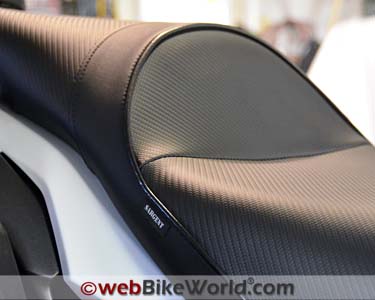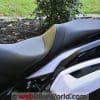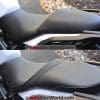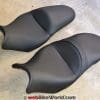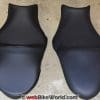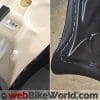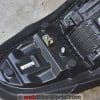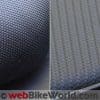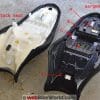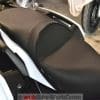The World Sport Performance seat is the original Sargent seat design.
It’s been manufactured since 1996 in stock and custom versions.
The price is reasonable, especially since you don’t have to trade in your old seat pan.
That means you can sell the Sargent seat to recoup some of the cost when you buy another motorcycle.
Nevertheless, I didn’t really want to spend the extra money.
But the stock seat on the 2015 Kawasaki Versys 650 LT Project Bike (Blog) is pretty awful, so it was either sell the bike or get a new seat.
The Sargent Seat solved most of the problems, although the differences are subtle.
Seats and Seats
The Sargent World Sport Performance seat has been available for many years and it’s been reviewed to death, so to speak.
So there’s not all that much more I can say about it that hasn’t already been said.
I’m pretty late to the Sargent seat party because I’ve had pretty good luck with stock seats. For example, the OE seat on the 2014 Suzuki V-Strom 1000 ABS (Blog) was about the only thing I liked about that bike.
I even tried an accessory SHAD seat (review) and returned it and went back to the stock saddle.
For the most part, as long as the seat is wide and flat, I’m OK with it.
But there are two things that really bother me: seats that force me into one position with little room for movement and seats with a rounded profile on top.
The worst example of #1 was the stock seat on the Suzuki GW250 (review) and I’d have to say, the worst example of #2 is the OE seat on the 2015 Versys 650.
The engine on the GW250 was a smooth-running screamer — literally — but the seat was the worst example of a motorcycle seat I’ve ever encountered.
It not only forced me into a rigid position with no movement, it sloped dramatically down towards the fuel tank, with consequent NRPS (Nether Region Pain Syndrome!).
I couldn’t get it fettled, so I sold the bike.
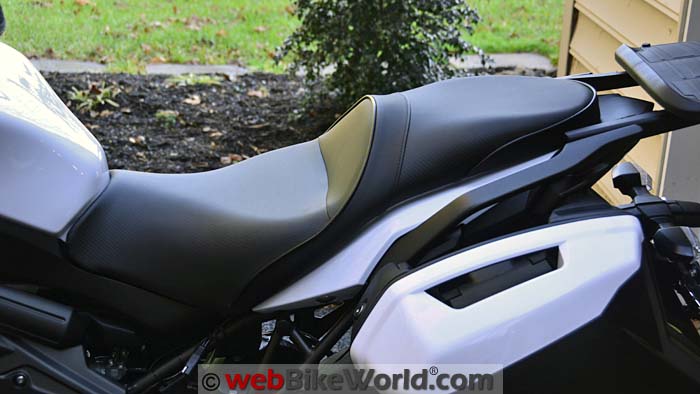
The Versys 650 Seat
The seat on the Versys looks and feels cheap. There’s just no two ways about it.
The seat cover is basic generic and the foam is as flabby as it gets. The seat pan is a cheap plastic molding with only a single metal part — the loop catch for the lock in the rear.
I could only ride for about 1/2 hour or so before I started to feel the beginnings of NRPS and it I seriously considered selling the bike because I didn’t have the patience to deal with the problem.
But just for kicks, I looked on the Sargent seat website and discovered they make a bunch of different seats for many different bikes, including the Versys.
I had no idea — I thought Sargent was only a custom seat manufacturer where I’d have to send my seat pan and wait two months or something for a new (and very expensive) seat to arrive.
You can still get a custom seat made but Sargent is pumping out seat replacements and there’s even a retail distribution system.
I bought mine at RevZilla for $429.95 (Yikes!) the webBikeWorld affiliate, but you can now evenbuy Sargent seats through this link to Amazon.com!
(When you click through the webBikeWorld affiliate links to buy a product, we make a few shekels and that’s the only revenue that keeps the site running).
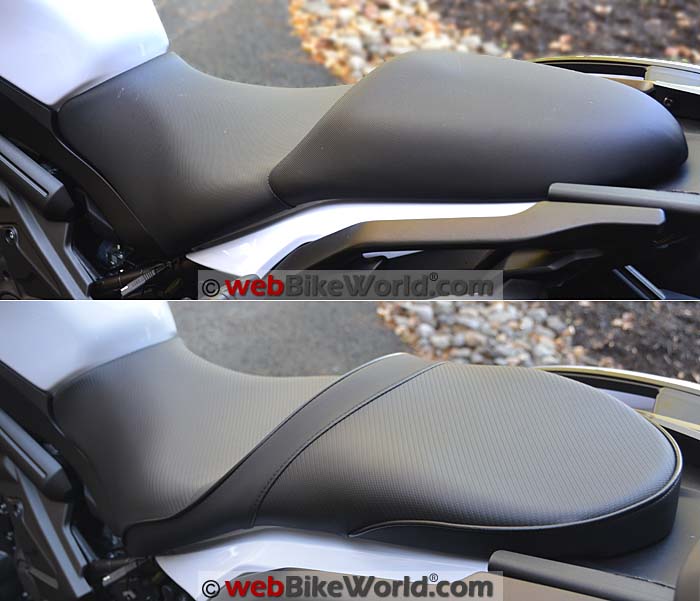
The Sargent World Sport Performance Seat
The first thing you’ll notice about the Sargent seat is the weight. This one weighs 3 kg (6.6 lbs.), compared to 2 kg (4.5 lbs.) for the stock seat. So there must be some ingredients in there that are heftier.
Flip it over and you’ll see a seat pan that puts the stock Kawasaki seat pan to shame. The Sargent seat pan or base is a complex molding, with no foam showing and metal parts all over.
It also has thick rubber bumpers, which may help tame vibrations, although I can’t say I notice much on the Versys anyway.
The Sargent seat also has a big vinyl-covered metal tab up front to slip under the receiver on the Versys. The stock seat has a plastic tab, molded as part of the seat pan.
The Sargent World Sport Performance seat comes in two heights, standard and a 1″ lower version. I bought the standard height because even though I could use more clearance, I didn’t want to drop the sitting leg length any lower.
The Versys has a bit of a strange seat-to-foot-peg dimension, which feels slightly cramped to me, even with a 31″ inseam.
World Sport Adventure Touring Seat
By the way, there’s also a World Sport Adventure Touring seat for dual-sport bikes. And if you order the seats directly from Sargent, you can have them customized with various options, including heat (at extra cost, of course).
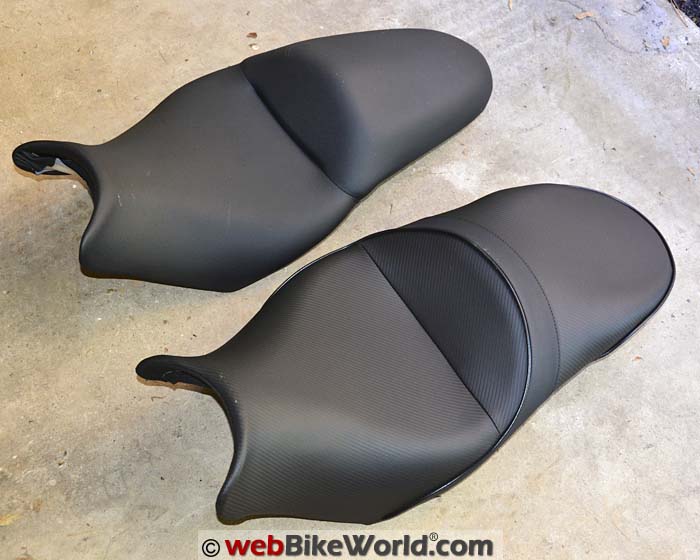
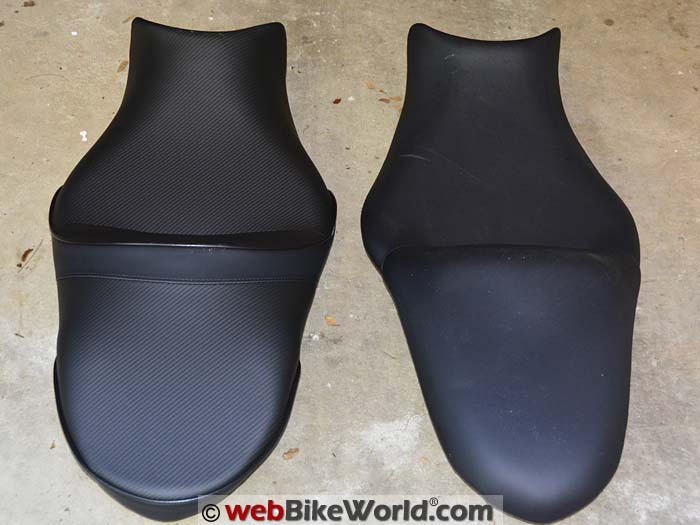
Installing the Seat
There’s nothing to installing the seat. Remove the stock seat and replace it with the Sargent seat (see our video).
You don’t have to swap over any parts, which is nice. That also means you can sell the Sargent seat if you sell the bike, which means you should be able to recoup at least 1/2 the cost.
The thick rubber bumpers that the stock seat doesn’t have make it a tight fit. I have to push down on the back of the Sargent seat to get it to “click” into the lock receiver at the rear (see video).
So basically, there’s absolutely nothing to installing the Sargent seat. Take the old one off; put the new one on.
On the Road
Due to the on/off winter weather, I’ve only put a few hundred miles on the Sargent seat.
I can’t say it’s a mind-blowingly amazing experience the first time I climbed aboard, so don’t expect miracles. The “Super Cell Atomic Foam” is very firm, so you’ll have to get used to that.
Sargent claims that it has “our own unique and proprietary blend of resilience, firmness, and vibration-absorption qualities.”
The new seat is slightly wider, about the same height (for the standard version) and flatter across the top.
The most significant difference is that I have some relief in the Nether Regions, and that’s important.
The outer covering looks and feels several notches above the stock seat for sure, but it’s a little slippery, which was surprising. I’m hoping it will gain more traction as it wears in over time.
I’m not 100% crazy about the seat stop or bumper or back rest — whatever it’s called.
I prefer bikes with a long, wide, flat open seat so I can move around. But the design of the Versys just doesn’t lend itself to that type of seat unfortunately.
I can ride for much longer than 1/2 hour though and not feel pain, so in that regard, it’s a winner.
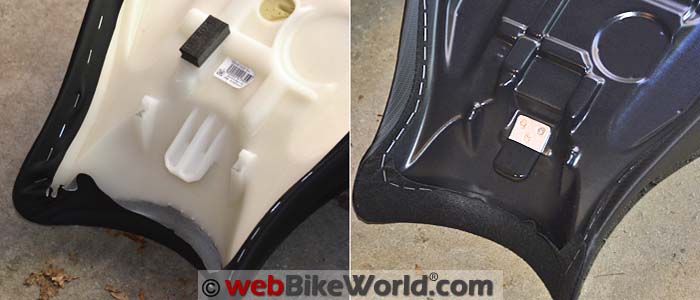
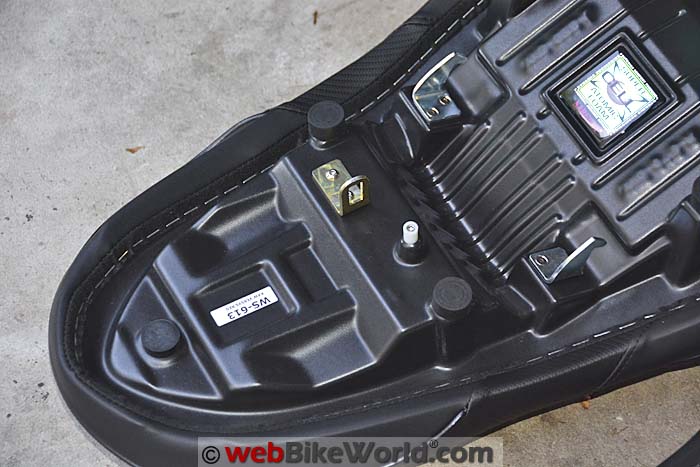
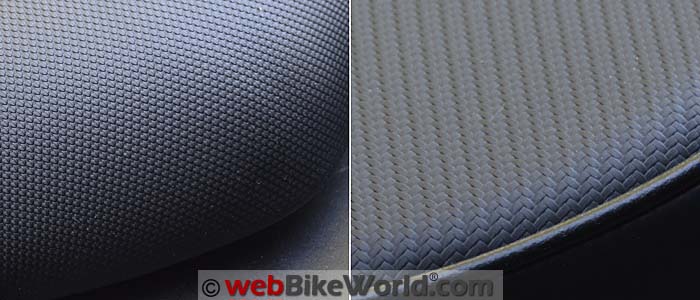
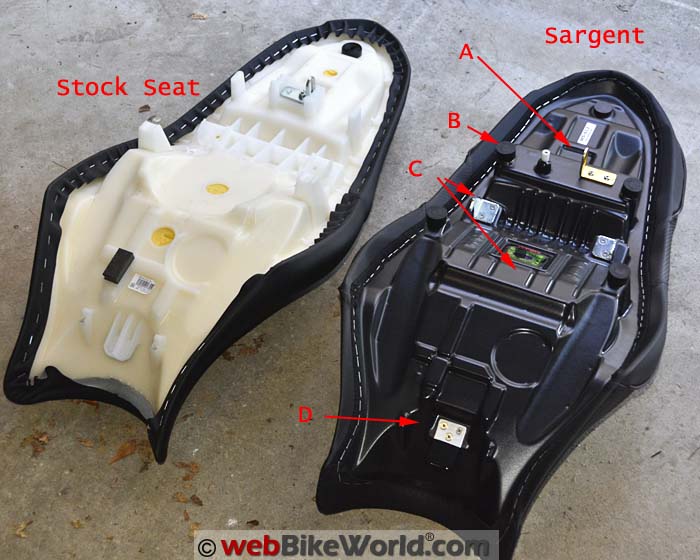
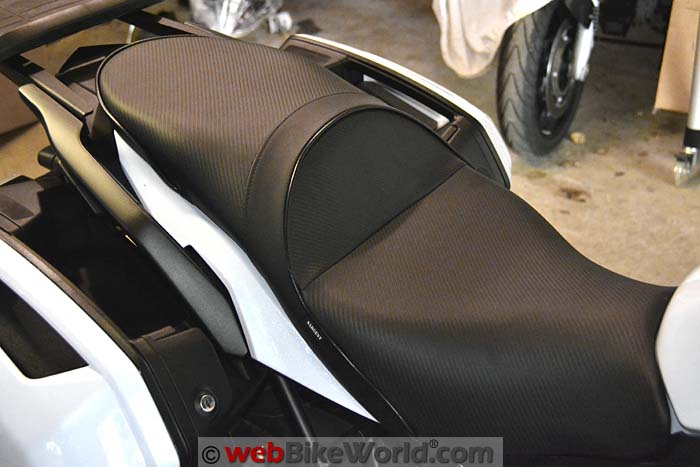
Conclusion
The Sargent World Sport Performance seat is nicely made and has a good-looking exterior.
It’s definitely a cut above the stock Kawasaki Versys seat, which can be summarized in just one word: cheap.
While there’s not a huge, magnificent difference that yields butt nirvana on the first ride, the Sargent seat eliminates Nether Region pain.
The Sargent seat is also slightly wider and while some owners report that the front is narrower, which makes it easier to reach the ground with their toes, I don’t notice any difference compared to the stock seat.
The new seat does feel more slippery than I’d like, but I’m hoping as the outer material becomes worn that this may change.
Otherwise, I’m happy with the Sargent seat — not overwhelmed — but it does make for a nicer experience when riding the Versys.
| wBW Review: Sargent World Sport Performance Seat | |
|---|---|
| Manufacturer: Sargent Cycle Products | List Price (2017): $279.90 and up |
| Colors: Black or Custom | Made In: U.S.A. |
| Review Date: February 2017 | |
Owner Comments and Feedback
See details on submitting comments.
From “H.S.” (March 2017): “For $300, may I suggest an alternative? The stock Versys seat is too sloped towards the front, and causes much pain — you’re forced into the tank constantly under braking.
On the Kawasaki Versys forum, several members have reported a solution in raising the front seat mount.
One member manufactures (printed plastic) a front seat riser for peanuts (under $15) that raises the front of the seat about a half inch.
I was one of the first buyers as I’ve had the same initial impression as you, and I can advise it has — for me — totally transformed the ride. I routinely do 3+ hours without discomfort, and do all day ADV rides with time on the pegs with zero butt or nads discomfort.
I agree the Versys seat is cheap, but it’s a cheap bike.
Check out the forum and try the seat riser mod and re-compare them (members report the bolt and washer method has identical results for about $4).
I was shopping for a replacement seat for mine, considered the Sargent, and thought, “why not”. I sold the second seat pan I had and have never looked back.
Lastly, I have to chide you a bit — the review sounds like you’re trying to find reasons to like the Sargent seat, and you’re pointing out irrelevant quality differences like the front tab being metal (has the plastic one ever failed?).
For me, a slippery seat cover is a poor design choice in a $300 seat.
End of the day, sounds like you would have been just as happy with the $15 fix.
And you would have $285 left over for more worthy purchases, like the fuel to ride about 6-7,000 miles since the seat is so much more comfortable (5 gal tank, 225-250 miles/tank, $2 gal in AZ). Love wBW, keep it up!”
Rick’s Reply: I think you can tell from the review, I wasn’t too enthusiastic about the seat, especially for the price.
I thought I’d get seat nirvana, but that didn’t happen, although the Sargent seat is fine and I’m happy with it.
But, as I mentioned in the review, the one problem I did NOT have was a sloping front on the seat.
In fact, I was and remain surprised to learn that some Versys owners say that the seat slopes in the front. I don’t see that on my stock seat and I don’t find that, nor have I experienced it at all with the stock seat.
It just is not the case for me at all, so a sloping seat was not something I needed to fix and not the reason why I bought the Sargent seat.
The big problem for me with the stock seat was the rounded curvature of the stock seat, especially the foam as it pushes under my butt and in between my legs.
And overall, the stock seat just feels about as cheaply made as possible and it transmits a lot of vibration.
So the Sargent seat is much better in that regard but like I said in the review, it’s not an earth-shattering difference.
The best part of the Sargent seat for me is that it’s flatter and has a tiny bit of relief in a concave under my butt. I could not ride with the stock seat for more than an hour but I can spend unlimited time on the Sargent seat no problem.
Also, the “shine” has worn off after a few rides, so it’s no longer slippery.
Would I buy it again? Yes.
But with regards to saving the money, this is all done in the interest of science so webBikeWorld readers can learn more and make their own decisions, so cost to me is pretty much irrelevant.
From “R.S.” (February 2017): “I’ve followed your website for a couple of years and have appreciated all of your advice, especially concerning helmets.
Your reviews have been the most important influence in my purchasing decisions. Maybe now I can return the favor in some small measure.
I just read and saw your video on the Sargent seat. I have a 2003 Honda VFR800 that I bought used four years ago. I was the fourth owner.
One of the previous owners had installed a Sargent World Performance seat. I have been riding since 1979. And I’ve never had a more comfortable motorcycle seat than this one. Even better than my 2003 Honda Goldwing.
I had a 2000 Honda VFR800 for a number of years with the stock seat, and it didn’t feel as good as this.
I know that the VFR model changed in 2003, so it’s not a completely “oranges-to-oranges” comparison, but it’s pretty close.
I’ve never owned an aftermarket seat before, so I can’t compare the merits of the Sargent to other aftermarket seat makers.
My only very limited experience with another brand has been two test-drives of motorcycles in the past that had Corbin seats on them, and my recollection of them was that they were firmer than the Sargent.
This is not a fair comparison by any means. And people have their own individual preferences regarding the relative firmness of seats.
I think that the seat will probably get less slippery as time goes on. I’ve never had that issue. And it seems to have the same materials as mine.
Of course, not being the original purchaser of the saddle, I don’t know how long it takes for that slippery feeling to go away. Good luck. And thanks again.”


